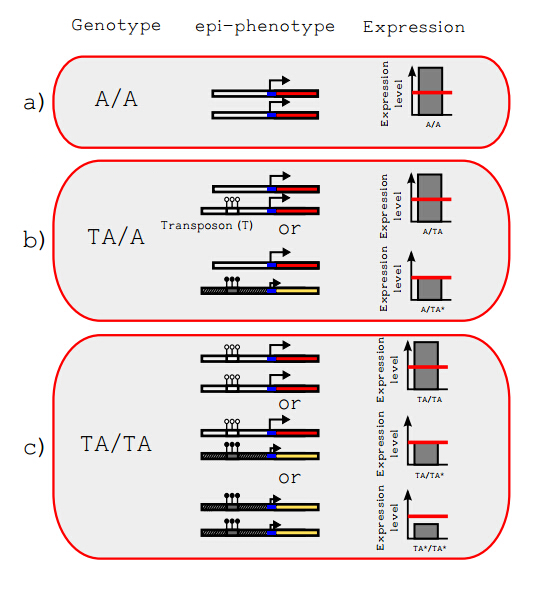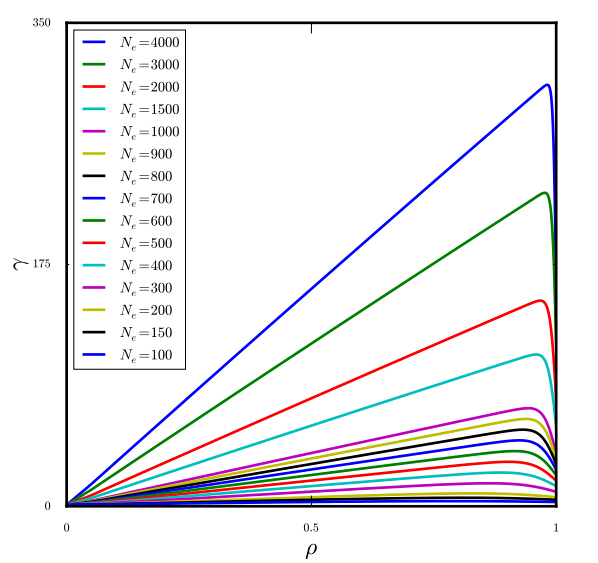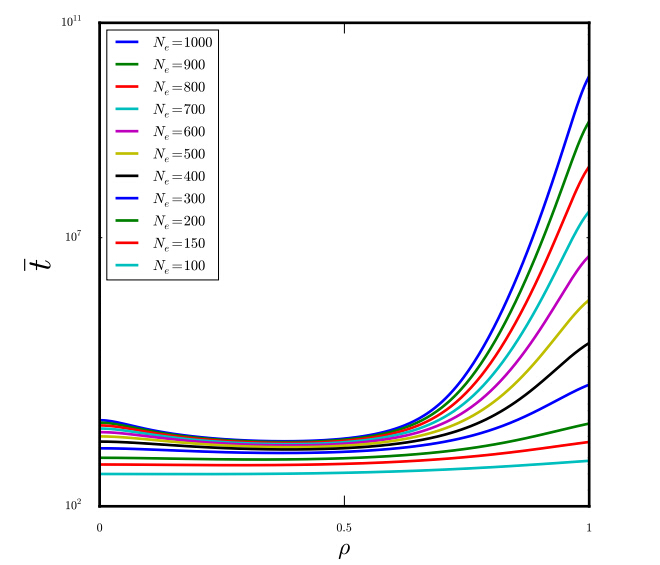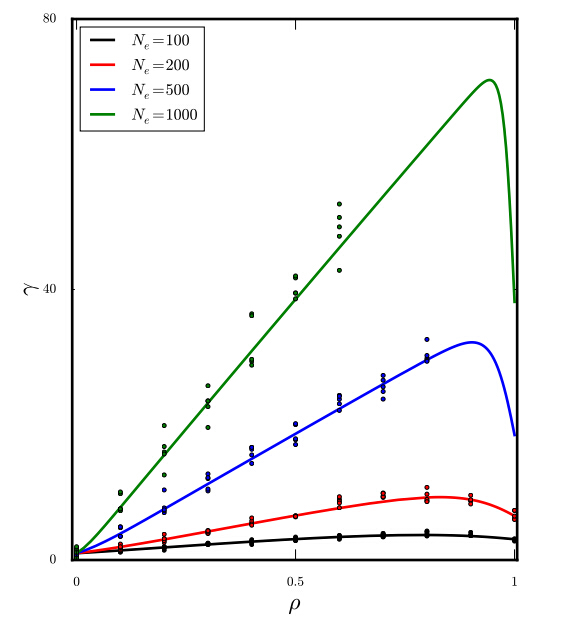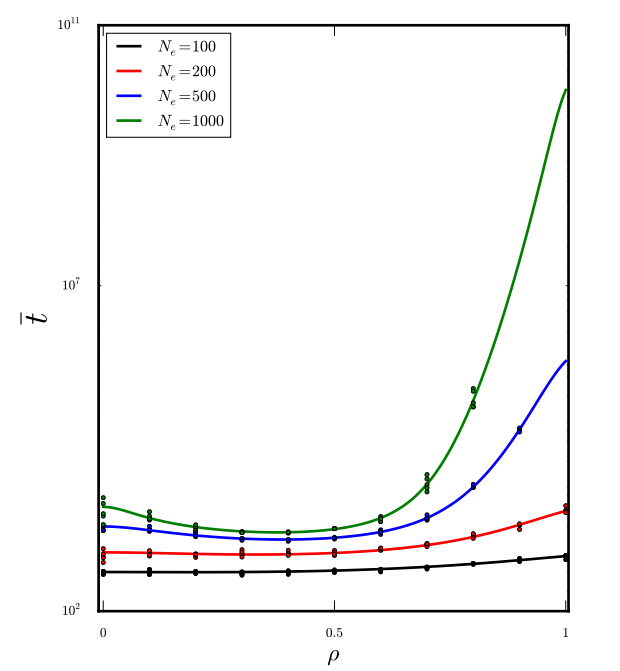1. Introduction
Transposons, which are elements that can self-replicate and move from one chromosomal location to another,
are a major source of genetic variation in both animal and plant genomes
[1, 2, 3], and, as such, are significant
contributors to evolutionary change [4, 5].
It is now generally recognized that in
addition to genetic variation, epigenetic variation also affects evolution [7],
especially in a fluctuating environment [8, 9, 10]. There
has been much interest in transgenerational epigenetic effects caused by input from
the environment (for a review see [7]). However, the treatment
presented here does not depend on transgenerational epigenetic effects. Strong
evidence is accumulating that epigenetic variation caused by genetic changes,
such as the insertion of
transposons, can affect expression of nearby genes, and importantly, epigenetic
variation and transposons have been linked with human
disease [11]. Transposons expression is usually, but not always,
silenced and kept harmless by epigenetic mechanisms.
We have commented on the interplay between evolution, epigenetic variation
and transposon activity before, but not to the
extent of mathematical modelling presented here [11, 12, 13, 14, 15].
In this paper we continue our study of the impact of Stochastic Epigenetic
Modifications (SEM) during developmental windows of opportunity in the early
embryo [12]. Two critical assumptions of the SEM model are that
stochastic epigenetic changes take place during a window of opportunity in the developing embryo, and then,
after closure of the developmental window, the epigenetic state of the affected
locus is propagated faithfully for the life of the organism, at least in some
cell lineages, thereby altering function of the adult. This allows selection
to be applied to any genetic change affecting the probability of establishment
of an altered epigenetic state controlling expression of a gene. Our previous
work [12, 13, 14], focused on
evolution by gene duplication, with the finding that SEM can both enhance the
fixation of duplicates and prevent pseudogenization. In our most recent paper,
we also presented some preliminary analysis of the effect of transposons
[12] after they were fixed in the population. Here we extend
this work to a consideration of the probability of fixation, and average time
of fixation, under the assumption that insertion of a transposon will affect,
in cis, the probability of epigenetic modification and thus expression level of
a nearby gene.
Though the exact nature of the epigenetic modification need not be specified
for the SEM model, for simplicity we will henceforth assume that the
modification is DNA methylation, since the stable somatic inheritance of
5-methylcytosine patterns in CpG doublets is well established. (However,
it should be noted that other, similar, mechanisms would automatically fit
into the model, because while our mathematical framework is well-defined,
it's quite flexible). There are numerous examples of stochastic DNA
methylation changes during developmental windows of opportunity followed
by faithful inheritance after the window closes. One example is caused by a
partial duplication of the H19/Igf2 imprint control region and results in
two phenotypes, large and small mice, with the same genotype
[15]. However, the best studied example of this is X chromosome
inactivation [16]. In the very early embryo, at about the time
of implantation of the blastocyst into the uterine wall, a random choice is
made in each cell as to whether the maternal or paternal X chromosome is
inactivated. Once this choice is made it is fixed. If the parent cell in
the early embryo has the maternal X inactive, all daughter cells derived
from this parent cell will not express most genes on the maternal X
chromosome. It is well established that the extremely stable somatic
heritability of X inactivation is due to DNA methylation specific to the
inactive X chromosome [17]. It addition to X-linked genes,
several hundred autosomal genes show random mono-allelic expression; this
also is determined during early differentiation, and, once established, is
highly stable and can contribute to changed function in a proportion of
cells [18, 19, 20]. Beyond this, there are
several examples of epialleles that affect mouse phenotype, and there is
evidence in both mouse and human that maternal nutrition during pregnancy
can have life-long effects on the expression of certain genes, with a
correlated change in DNA methylation [21]. Though the
importance of nutrition in an epigenetic context is important, we emphasize
that our modeling assumes that the epigenetic landscape is reset entirely
each generation, i.e., there is no transgenerational effects. As reviewed in [22], several murine
epialleles (e.g. Avy, AxinFu,
CabpIAP) have been identified in which the activity of a
retrotransposon controls expression of an adjacent gene
[23]. Variable expressivity results from stochastic
epigenetic modification of the 5' long terminal repeat (LTR) of the
retrotransposon, producing genetically identical individuals with different
phenotypes. The epigenetic state of the retrotransposon varies between
individuals but, in a given individual, the epigenetic state is similar
between tissues. The difference between epialleles (and adult individuals)
is thought to arise from stochastic events in the early embryo, in a window
of opportunity before the three primary germ layers are determined. After
the window closes the epigenetic state of the retroposon is progagated
faithfully in somatic cells. In the case of Avy it seems
clear that DNA methylation at the LTR of a retroposon upstream of the the
agouti yellow gene affects expression of agouti. If the LTR is umethylated,
the mice are obese with yellow coat color; if the LTR is methylated, the
mice are normal weight, with agouti coat color. It should be noted that
the location of the transposon can be quite far from the affected gene and
can be either upstream or downstream. For example, the Avy
insertion is located 100 Kb upstream of the Agouti gene, with the LTR
providing an alternative promoter if unmethylated [24]. In
addition to alternate promoters, it is now known that long noncoding RNAs
(lncRNAs) are common, often in antisense orientation, and these can affect
cis-located genes [25]. For example, the Tsix promoter,
which is involved in X chromosome inactivation, drives transcription of a
lncRNA that prevents, in cis, expression of Xist, whose promoter is located
over 30 kb from the Tsix promoter [26]. There is also
evidence that in embryonic stem cells certain sequences in LTRs act as
binding sites for zinc finger proteins, which then attract additional
proteins that favor formation of repressive heterochromatin, expression
silencing and DNA methylation [27]. In such systems, the
repressive heterochromatin has been shown to spread and silence genes at
least 1 kb from the site of insertion. One major function of DNA
methylation in mammals is to help control the activity of transposons,
especially in somatic cells, which have a relatively high level of
methylation [28]. However, both mouse and human DNA becomes
relatively less methylated (hypomethylated) at two developmental stages,
early gametogenesis and between fertilization and late blastocyst
[28, 29, 30]. Though DNA in
primordial germ cells is hypomethylated, it becomes highly methylated again
during gamete maturation; both oocyte and sperm DNA are highly methylated.
After fertilization, there is a wave of active and passive demethylation,
first on the paternal genome and then on the maternal, leading to a low
methylation state in the blastocyst just before implantation. After
implantation, a wave of de novo methylation occurs, again creating a
relatively high level of DNA methylation, with a pattern that then is
mostly conserved by maintenance methylation during further cell divisions,
lineage specification and maturation to specific cell types. Most
transposons are demethylated along with the rest of the genomic DNA in the
zygote and early embryo, and increased expression of transposons correlates
with their demethylation. At least some demethylated LTRs function as promoters and are active in the early embryo.
However the demethylation of transposons in the early embryo is incomplete;
for mouse and humans 30-40% methylation remains, increasing to 80% or
more after differentiation [28, 29, 30]. While it is not yet certain whether demethylation
(and then remethylation) of transposon LTRs takes place stochastically
and independently on the maternal or paternal genome, as we assume
here, it is known that the phenotype of Agouti yellow mice, which is
due to the Avy transponson, is variable and consistent
with stochastically incomplete and variable demethylation and/or
remethylation events at the LTR in the early embryo, before
specification of the three primary germ layers [24].
2. Modeling
Our intention was to expand the existing models of
evolutionary behavior of a transposon sequence (T), and the role it might play
in a regulation of a downstream gene (A). We were specifically interested in
(i) the probability, and (ii) time of fixation of locus TA initially present in
the population at frequency P in a randomly mating diploid population of
effective size Ne. The probability of fixation, and the time of
fixation, of a locus are two factors that determine whether the locus
in question will be maintained in a population. For modeling purposes we
assume an initial state where the expression level of the gene A is higher than
the "optimal" level (Fig 1). Such a situation could occur for any number of
reasons that disrupt the status quo: environmental changes, migration; in
general, everything that can alter the fitness landscape of the population
(species) in question. We assume that the epigenetic effect of transposon T
triggers the establishment of repressive heterochromatin whose influence extends to gene
A. We further assume that gene silencing is manifested during development and
that the status of the locus TA (silenced or active) is preserved during the life
of the organism. At each generation, however, the epigenetic memory is
effectively "reset" and the probability of silencing (or not) of the locus
depends only on the presence or absence of transposon T and its own probability
to be silenced. Thus, the fixation of T leads to a much higher fixation
probability of A. The process is still driven by a selection
mechanism, but a stochastic event during development is introduced that leads
to multiple phenotypes from a single genotype.
We pursued two avenues of investigation: analytical framework (diffusion
equation) and computer simulations. Once again, the goal was to estimate the
probability, and average time, of fixation for the locus TA. The relative
frequencies of the corresponding epi-phenotypes (and their fitnesses) are shown
in Table 1 (genotype/epi-phenotype/fitness map). Assuming the average fitness
(W) associated with each genotype TA/TA, TA/A and A/A, we
used the standard diffusion equation framework to model the evolution of the
system.
Table 1. Transposon model 1 genotype/epi-phenotype/fitness map.
2.1 SEM Affects the Probability of Fixation.
The probability of fixation u(P) for the locus TA is
|
u(P)=∫P0e−8Nρsx(1−ρx)dx∫10e−8Nρsx(1−ρx)dx
|
(3)
|
Results of the numerical integration of equation (3) are shown in Figure 2 where γ the scaled probability of fixation
(given by γ=2Neu(P)) of locus TA is plotted vs probability of epigenetic
silencing ρ. Calculations were performed with initial frequency of TA given by P = 1/2Ne and s=0.01.
From Figure 2 we can observe that γ exhibits behaviour corresponding to
a positive selection drive increasing with Ne. Moreover, when ρ equals zero, the system
behaves statically, meaning that if the transposon has no chance to be
epigenetically silenced (ρ=0), it has consequentially no effect on locus
A, and therefore the fixation in such a situation is equivalent to a neutral
event (i.e. γ=1. As ρ increases, γ increases as well,
reaching a maximum value when ρ is between 0.5 and 1,
depending on the population size. Thus γ measures the relative advantage
of the TSM model over standard neutral drift. We conclude that SEM with TSM
is advantageous for fixation, with the relative advantage increasing with
effective population size.
2.2 SEM Affects the Time of Fixation.
In
order to better understand the evolutionary dynamics of the system, we have
also computed the average time of fixation (t) of the locus with the
inserted transposon.
|
ˉt(p)=∫1Pψ(x)u(x)(1−u(x))dx+1−u(P)u(P)∫P0ψu2(x)dx
|
(4)
|
where
and
Results of numerical integration of equation (4) are shown in Figure 3.
When ρ equals zero, fixation of TA essentially becomes a neutral evolution process.
For larger values of Ne the time of fixation t(ρ) appears to attain a
minimum and exhibits exponential growth towards the end of the interval. This behavior is interesting and
makes perfect biological sense when one considers the relative fitness of
TA/TA (W11), A/A (W12]) and A/A (W22) as ρ changes.
With ρ = 0 W11=W12=W22 the system is essentially into the
neutral evolution mode. With 0 < ρ < 0.5, W11 > W12 > W22 the
fixation of TA is positively driven by selection. When ρ = 0.5,
W11=W12>W22 and the system behaves as "dominant" in regard to fixation
of TA. Finally, for ρ > 0.5 the insertion of TA has an "overdominant"
effect, W12 > W22 ≥ W11 i.e. the heterozygotes have a larger
selective advantages than both homozygotes, with the special case
W22=W11 for ρ=1.
2.3. Computer Simulation and Comparison
with Analytical Approach.
To confirm the results obtained by the diffusion
approximation we also performed a Monte Carlo simulation and compared the
results with those generated by equations (3) and (4) for γ and
t. Simulation entailed the following steps:
1. A population is initialized starting with 2Ne - p gametes A and P
gametes TA (with 2Ne p=1).
2. 2Ne gametes are sampled with replacement (i.e., the infinite pool
model) following their corresponding fitness and epi-phenotype frequencies.
Subsequently, the adult individuals produce gametes following their
corresponding allele frequencies.
3. Steps 2 is repeated until fixation of A or TA.
4. To obtain an estimate of γ and t, simulations are repeated
100, 000 times for each set of parameters.
5. Repeat the entire procedure five times.
Results of simulation experiments are shown in Figure 4 and 5, where it can be seen that
there is an agreement with equation (3) and (4), respectively.
3. Discussion
We find that stochastic epigenetic modification (SEM) of a newly inserted
transposon during a developmental window can greatly increase both the rate and
probability of fixation of the new element (and associated expression of a
nearby gene), with the advantage provided by SEM increasing with Ne. These
conclusions are based on quantitative calculations of γ, the scaled
probability of fixation, and t, the time to fixation, for different
values of ρ, the probability of transposon silencing. The two approaches
in the study are, first, an analytical treatment based on diffusion equations,
and, second, a simulation-based analysis.
Assumptions. A key question is whether the following biological
assumptions are reasonable: (1) stochastically incomplete epigenetic silencing
takes place only during a transient, relatively short developmental window, (2)
stable somatic inheritance of the resultant epigenetic state, and (3) full
resetting of epigenetic marks at each generation. Without question, epigenetic
modifications affect function and can be somatically heritable; this is the
case for both DNA methylation and for histone/chromatin modifications
[31, 32] DNA methylation, which is strongly
associated with transcriptional silencing, is considered to be the most stable
and heritable of these epigenetic marks. Moreover, a major function of DNA
methylation is thought to be the control of transposon activity
[1]. However, for mammals there is solid evidence for a wave of
DNA demethylation (removal of epigenetic mark) following fertilization and then
remethylation (re-addition of the mark) at about the time of implantation of
the early embryo into the uterine wall. Waves of demethylation and
remethylation also are seen during gametogenesis. In addition, there is
evidence for specific changes in DNA methylation at key regulatory elements
during later lineage commitment stages [34]. Genome-wide studies
of DNA methylation in the early preimplantation embryo suggest that
demethylation of transposons is usually incomplete. Transposons are highly
methylated in the gametes (~ 80%, declining after fertilization to
30-40% methylation by late blastocyst). Even for specific genes and gene
control elements, a general feature of DNA methylation, when analyzed at single
nucleotide resolution by bisulfite sequencing, is an apparently stochastic
variation between molecules, as molecules with multiple CpG sites very often
have somewhat different methylation patterns. This suggests that there is
variation between cells. For X-linked genes subject to X chromosome
inactivation, it is very clear that the variation in DNA methylation seen at
promoters in adult somatic cells is in large part derived from a stochastic
epigenetic event(s) in the preimplantation embryo, which is fixed at the time
of implantation and then faithfully propagated in somatic cells
[16]. At about the time of implantation there is choice made in
each cell as to which X chromosome is to become inactive. The choice usually
is random; in each cell both the maternal and paternal X chromosome have a 50
percent chance of inactivation, and studies of the percent of cells expressing
either the maternal or paternal X have established that the inactivation is
indeed stochastic. Thus this phenomenon is an excellent example of a
stochastic event in the early embryo that becomes fixed (and thereafter
mitotically stable) in the late blastocyst. DNA methylation at promoters
correlates with the inactive state and is the epigenetic mark responsible for
the stable inheritance of X inactivation. Also of interest is that the entire
inactive X chromosome becomes condensed and cytologically recognizable as
heterochromatin. As mentioned in the Introduction, several alleles in the mouse
are known to cause two phenotypes from one homozygous genotype [15, 16, 22].
Most relevant for this paper is the fact that a transposon inserted 100
Kb upstream of the Agouti gene can cause two different adult phenotypes,
depending on whether or not the transposon insertion is methylated.
With regard to the third assumption, it is now well recognized that in both plants
and animals epigenetic changes, such as those caused by repetitive elements,
are often difficult to distinguish from "true" genetic changes except by their
response to inhibitors of DNA methylation [35]. Two examples highly relevant
for this paper are random monallelic expression of autosomal genes [16], and metastable epi-alleles
that are sensitive to maternal nutrition or stress [22]. Much recent
interest has focused on the fact that maternal nutrition can cause
epigenetic changes in the offspring, and these may persist for more than one
generation. This brings to the fore the possibility of Lamarckian genetics.
We do not argue against this, but our analysis does not depend on any such
transgenerational effects, since we assume full resetting of epigenetic
marks at each generation. The advantages of epigenetic variability in a
fluctuating environment have been modeled [8], but this analysis focuses only
on genes that affect the overall, genome-wide probability of epigenetic modification.
We focus on cis-action, although gene-specific trans-activity is not
excluded. Chess et al. have recognized that random mono-allelic expression
of autosomal genes has implications for evolution [16, 19], but we are
not aware of any work other than ours that has suggested a mathematical
treatment for encompassing cis-acting elements.
Generalizability. Transposons carry promoters and transcription
termination signals that can affect expression of cis-located genes, and they
also tend to be rendered inactive by epigenetic modifications [1].
Enhancers act at a distance, are often epigenetically modified, and the
modification is changed during development [36]. As a general
principle, it should be possible to adapt / expand the TSM/SEM model to any
genetic change(s) (or combination thereof) that acts at a distance and is
stochastically and incompletely modified during a developmental window. A
mutation that affects the spread of heterochromatin could, for example, cause
position-effect variegation, similar to that seen in Drosophila
[37]. Figure 1 could be interpreted as the variable spread of
heterochromatin from any new element, duplication or mutation, and it could be
modeled by the equations derived. In fact, any genetic alteration that affects
the probability of changed expression at another genetic element (protein
coding genes, lncRNA, miRNA, etc.) that could be selected for or
against during evolution, would fit into our modeling framework. Transposons
are just one (although very likely) way to change the probability of
expression; other factors (enhancers, promoters, unidentified SNPs) can lead to
the same result. The model is robust with regard to the specific mechanism.
For example, if the new element or mutation affects expression only when
unmethylated, rather than methylated, the mathematical approach and biological
results would remain the same. As an independent biological validation of our
model, it is worth noting that an element has been found, the X controlling
element (Xce), which has alleles that change the probability of X chromosome
inactivation from 50:50 to, for example, 70:30 [38]. Whether
DNA methylation is involved in the function of this element is not known, but
is clear that a genetic element can change the probability of an epigenetic
event controlling expression only of cis-located genes; in this case X-linked
genes.
Overdominance and population polymorphisms. It should be noted that
the behavioral pattern of an inserted element can vary from neutral to dominant
to overdominant as ρ varies from 0 to near 1.0. Under the "overdominant"
model, heterozygotes have a selective advantage: while the probability of
fixation is increasing, the "time" of fixation becomes exceedingly remote. The
element might become common in the population, but will never become homozygous
in a stable environment under constant selection pressure. This means that
heterozygotes do indeed have a selective advantage: under the given constraints
(e.g., see Figures 2 and 3) while the probability of fixation is increasing,
the time of fixation becomes unrealistic: the element might become common in
the population, but will never become homozygous in a constant environment,
under constant selection pressure.
In all cases considered here expression of locus A starts as bi-allelic and
evolves (under selection drive) to the final (random) mono-allelic stage.
Analysis of a two-step process, where first a polymorphism accumulates and then
selection changes, will be the subject of future work, which has implications
for macro-evolution including evolution of mono-allelic expression, nervous
system function, and the immune system, both innate and adaptive.
It should be mentioned that interaction between epigenetic regulation,
transposons and (micro-) evolution has long been recognized as an important
topic in A. thaliana} and other agricultural plant research
[3, 39, 40, 41]. However,
only recently have attempts been made to extend the concept to other species
[42, 43]. We feel very strongly that a robust
mathematical framework is needed to support the conjectures regarding the above
interplay, and we present some of it in this paper. To our knowledge, this is
the first attempt to do so. Our analyses are "generic" with respect to the
species, so by adjusting standard population genetics parameters (effective
population size, fitness, etc.) they can be generalized to various
organisms. This study in general, and our methodology in particular, were
intentionally designed to work on a larger (macro-) evolutionary scale.
Hence, the connection to the neo-functionalization and sub-functionalization by
gene duplication. A number of plausible scenarios have been proposed (see
[44] and [45] for some recent perspective), but the
general consensus is that there are many mechanisms that can potentially aid
emergence and fixation of new genes and functions (escaping pseudogenization).
We do not intend to claim that the mechanism modelled in this report is the
only mechanism; however, our belief is that it is a strong, perhaps at times
decisive, factor, and this belief is supported by both analytical and
simulation experiments results. Our main conclusion is this: under realistic
evolutionary / population genetics conditions and parameters, transposon
insertion can create a stable polymorphism in the population, and, that the
behavior of the retrotransposon strongly depends on the epigenetic
regulation.
Caveats. Three caveats should be considered, which also brings us to
the following prospective future research directions: One, the system under
consideration is fundamentally a multifactorial system that, at this time, we
are treating in a unifactorial way. As a follow-up to this research, we plan to
use Dynamic Bayesian (Belief) Networks [46] to expand on our
modeling, including visualization of the dynamics of the evolutionary
processes. We also intend to explore other alternatives, such as entropic
analysis, which we believe is a promising direction, and although there is only
one study to that effect [47], we feel that combining the
multifactorial entropic (non-parametric) analysis of large-scale data with
epigenetic modeling is arguably the most promising venue. In a more general
sense, a quantitative data analysis framework that includes "standard"
phylogenetics (or perhaps coalescent, depending on the evolutionary scale)
and epigenetic data is desperately needed. While there are some
notable recent advances [48, 49], they are few and
far between. There has been substantial progress in incorporating different
data types and levels of biological abstraction in computational evolution data
analysis machinery, ranging from next generation sequencing to metabolomics ---
sadly, epigenetics is not quite "there" yet.
The second caveat has to do with our inadequate ability to deal with extremely
large effective population size when it comes to the simulation. There are
computational limits to that, even with the latest-generation workstations and
clusters. We intend to address this in the future by parallelizing some of our
computations, improving tractability of the problem.
The third caveat is that one cannot be certain to what extent the epigenetic
process is fully a Markov one. However, the model presented here is probably
the best (compact) fit, considering the biological knowledge we have right now
and, as the field progresses, we intend to expand the model accordingly. We
should emphasize that our model is in essence "non-Lamarckian" because at each
generation the memory of epigenetic marks is reset. At this time, our intent
is that the proposed model does not imply (or need) any epigenetic-based
transgenerational effects, although it could certainly be expanded to
accommodate such if the need arises.
Predictions and Experimental Testing. Our earlier paper on SEM
emphasized duplications [12], with the assumption that they
were epigenetically marked during gametogenesis and then subject to stochastic
events during a developmental window. There is recent experimental evidence
that duplicates are indeed epigenetically marked. Keller and Yi
[10] have demonstrated that evolutionary young duplicate genes are
initially heavily methylated and then gradually lose DNA methylation with
evolutionary age. Chang and Liao [50] found that duplicate genes
tend to be heavily methylated and concluded that DNA methylation plays a
dominant role in dosage rebalance after gene duplication. With respect to
developmental windows for stochastic changes, it is becoming increasingly
apparent that, in addition to random X chromosome inactivation, random
mono-allelic gene expression (RMAE) can be detected in 5-10% of autosomal
genes [16, 19]. RMAE studies of cloned cells have
clearly shown variability consistent with stochastic events during
developmental windows, and the number of genes showing RMAE has been found to
increase upon stem cell differentiation [18],
[20]. Of great interest is a recent report by Toyoda
et al. [51] showing stochastic selection in neurons of
individual promoters of the clustered protocadherin family, with the
probability of expression being controlled by DNA methylation in the early
embryo. As a result of recent advances, it is now possible, though technically
challenging, to directly measure DNA methylation changes in single cells
[52, 53, 54]. In fact, on the
basis of their single-cell studies, Lorthongpanich et al.
[52] have concluded that there is epigenetic chimerism in
preimplantation embryos. Thus single-cell analysis of both expression and DNA
methylation may enable direct testing of the prediction that duplicates,
transposons, and probably other DNA elements will show stochastic variability
between individual cells in the preimplantation embryo and in some cell
lineages. Another promising approach, only now becoming practical, is the use
of CRISPR and TALEN technology [55] to make locus-specific
transposon insertions, mutations and duplications in ES cells and then assay
for methylation and expression at the single cell level during in vitro and in
vivo differentiation. Thus, the key assumptions, and the conclusions of
modeling addressed in this paper are experimentally testable, and it is our
intention to continue pursuing this research direction.
4. Conclusion
We conclude that stochastic modifications of a newly inserted transposon
element during a developmental window could significantly affect both the
rate and the probability of fixation of the transposon and nearby gene
alleles. We used two approaches in the study. First, an analytical treatment
based on diffusion equations, and, second, a simulation-based analysis. Importantly, both approaches are in
agreement, which bodes well for future research in this area. In summary, we present a laconic but
flexible quantitative framework that, while generalizable, was first and foremost developed to assess whether the combination
of epigenetic effects and transposons could be one of the principal factors in both macro- and micro- evolution.
We show the evidence to that effect. We also advocate development of the evolutionary data analysis algorithms
and methods that incorporates epigenetic data, as it is long overdue.
Acknowledgments
S.B. is a Susumu Ohno Distinguished Fellow and A.S.R. holds the Susumu Ohno
Chair in Theoretical Biology at Beckman Research Institute of the City of Hope.
We would like to acknowledge the late Sergei N. Rodin who was instrumental in
starting this work.










 DownLoad:
DownLoad: 





